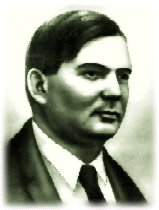|
IMRE BRÓDY (1891 - 1944) |
 |
Born in Gyula, Imre Bródy was university educated in Budapest and became a physicist. He wrote his doctoral dissertation on the chemical constant of monoatomic gases. First he taught high school, then he became an assistant professor in the department of applied physics at the University of Sciences. Early in his career he accomplished valuable theoretical work investigating specific heat and molecular heat. For a short period beginning in 1920 he worked with Max Born as assistant to the professor in Göttingen. They jointly worked out the dynamic theory of crystals. He returned home in 1923 and worked at Tungsram as an engineer until the end of his life.
His most important invention dates from 1930. He filled lamps with krypton gas in lieu of argon. Since the new gas was expensive, he developed a process with his colleagues to obtain krypton from air. Production of krypton filled lamps based on his invention started at Ajka in 1937.
Subsequently Bródy worked on new light source problems. He remained with his family after the German occupation of Hungary in 1944, and despite of the immunity the factory provided for him, he succumbed to certain death. He died on December 20, 1944 in Mühldorf as a victim of fascism.
The Eötvös Loránd Society of Physics named a prize after him, thus commemorating his life's work.
Gas filled metal filament incandescent lamp (1930)
Late in the last century, scientists engaged in the radiation theory of incandescent bodies had already proved that an incandescent body radiates its energy mostly in the form of heat, and only a small part as light.
Bródy put his finger on the most important problems of incandescent lamp production. According to his hypothesis, the exit of evaporating tungsten atoms from the incandescent filament through the medium of gas was regulated not by diffusion only, as it was assumed, but was also influenced by other laws of nature. To eliminate such problems, he used gas of great molecular weight, thus attaining a longer life for the lamp. He chose the length and diameter of the incandescent wire in such a way that the filament's glowing heat be increased without reducing the lamp's life span. By using krypton gas, he developed an up-to-date lamp with longer life and better performance.
He also developed a new process to ascertain the krypton content of air. At the cost of a few years' work he demonstrated that krypton gas could be mass-produced at a cheap rate. Advantage of the krypton lamp was to emit more light without increased energy consumption.
Its display at the Budapest Industrial Fair in 1936 was a technical sensation.

